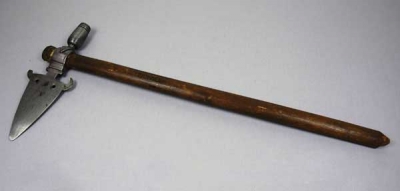Pipe tomahawk (1921.53.2)
 USAPipe tomahawk from the USA, Americas. Collected by Jean Frederic de Waldeck. Given to the Museum by Louis Colville Gray Clarke in 1921.
USAPipe tomahawk from the USA, Americas. Collected by Jean Frederic de Waldeck. Given to the Museum by Louis Colville Gray Clarke in 1921.
This is a North Amercian pipe tomahawk of the late 19th century. An ingenious combination of smoking pipe and weapon, it was used in trade and diplomatic agreements between the white settlers and the Native tribes.
In this example, the iron blade is fashioned into a bull's head with horns and two eyeholes. It is of the old-fashioned spontoon or 'French' style, either after its resemblance to the polearms of 17th century French colonists - which were still carried by military officers during the American Civil War - or the curling horns, which evoke the fleur-de-lis. The blade is hafted onto a hollowed, wooden handle and a tobacco bowl was attached to the poll (the back section) of the blade. The handle is made of ash, a common choice as it is strong, elastic and has soft heartwood that is easily bored out with a hot iron.
A Place in History
The true metal tomahawk acquired its name from the Renape Indians and was first recorded as a term by Captain Smith (of Pocahontas fame) as tamahagan - an axe or implement used for cutting. It was the European realisation of the saleability of axe heads which drove them to flood North America with trade axe blades, and their lack of understanding of Native American cultural and linguistic variation which led them to apply the term tomahawk wherever that trade went on. The Native Americans themselves took up the term, in the rational understanding that tomahawk was the word the Europeans themselves used.
The pipe tomahawk (or 'smoak tomahawk', as it was called by the English colonials) was recorded as early as 1700. It was a major commodity used in the fur trade that dominated north-eastern North America between 1650 and 1870. It is often asserted that pipe tomahawk blades were mass produced in Europe (generally, England), for supply to the North American fur market but few bear standard manufacturer's trademark stamps and it is more likely that the most blades were home-wrought by American settlers. This blade is unusual, therefore, in bearing a name, 'O.B. Sprague'. O.B. Sprague was recorded as working as a blacksmith in the small logging town of Spruce in West Virginia in 1905. This was the year the town's mill was built on the Cass railroad. Spruce no longer exists and whether this is the same O. B. Sprague, or whether he made this tomahawk blade before of after his time in West Virginia, may never be known. What can be ascertained is that there was not much need for a tomahawk in a logging town and if it was wrought there, it may represent an example of tourist art, or a dress/ceremonial tomahawk made for trade to Indians.
The pipe tomahawk was a regular feature of peaceful dealings between white Americans and Native Americans in the central-northern and eastern regions during the 17th to 19th centuries. Worn by tribal chiefs as items of prestige and used in diplomatic councils, their dual nature carried a powerful message: unless the pipe was smoked to seal the peace, war could break out.





